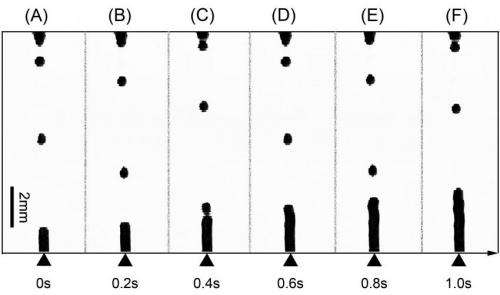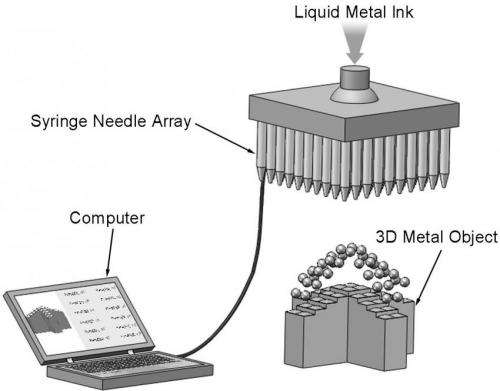Chinese scientists unveil liquid phase 3-D printing method using low melting metal alloy ink

Three-dimensional metal printing technology is an expanding field that has enormous potential applications in areas ranging from supporting structures, functional electronics to medical devices. Conventional 3D metal printing is generally restricted to metals with a high melting point, and the process is rather time consuming.
Now scientists at the Beijing Key Laboratory of CryoBiomedical Engineering, part of the Technical Institute of Physics and Chemistry at the Chinese Academy of Sciences, have developed a new conceptual 3D printing method with "ink" consisting of a metal alloy that has a melting point slightly above room temperature.
In a new study published by the journal Science China Technological Sciences, researchers Liu Jing and Wang Lei present a liquid-phase 3D printing technique for the rapid manufacturing of a conductive metal object in one, two or three dimensions. Compared with air cooling in conventional 3D printing, their liquid-phase manufacturing process prevents the metal ink from oxidation.
They outline their findings in a study entitled "Liquid phase 3D printing for quickly manufacturing conductive metal objects with a low melting point alloy ink."
In recent years, these scientists state, metals with a low melting point, especially metals that melt at room temperature, have attracted extensive attention in the areas of computer chip cooling, thermal interface materials, and microfluidics. "Such material has also been proposed as printing ink with evident value in direct writing electronics and 3D printing technology," the Beijing researchers add. In their new study, a four-element alloy, Bi35In48.6Sn16Zn0.4, was developed and adopted as the printing ink.
These scientists likewise developed a streamlined fabrication process.
First, a 3D object is generated as a computer-aided design (CAD) model, and then converted into an STL (STereoLithography) file. The STL file is imported into an open source software program that generates slices of the object as a set of horizontal layers and that generates tool paths for each layer. The printing ink is dropped into a liquid phase cooling fluid via an injection needle; the object is printed layer by layer.

During the process of liquid phase 3D printing, several factors affect the final printing quality.
The types and properties of the printing ink dominate the fabrication process. In principle, any metal with a low melting point (or less than 300°C) can be selected as a printing ink on condition that an appropriate cooling liquid is available. The ink material can be an alloy based on gallium, bismuth, or indium, or even a mixture of these alloys and nanoparticles.

Compared to conventional metal prototyping techniques, liquid phase 3D printing offers several distinct advantages: (1) At a relatively high speed of manufacturing, the process of printing metal objects in a liquid phase can be used to form three-dimensional structures. The temperature field and flow field of the cooling fluid can be flexibly controlled. Through regulating the flow velocity and direction of the cooling fluid, some unique 3D metal structures can be realized, e.g. a 3D rotating body. (2) 3D electromechanical systems can be printed. A conductive liquid metal can be used in conjunction with nonmetal materials (e.g. plastic) to form 3D functional devices that include supporting structures and conductive devices. The combination of liquid phase 3D printing and conventional printing can meet all kinds of objectives.
In the new study, researchers at the Beijing Key Laboratory of CryoBiomedical Engineering also describe the contours of a liquid phase 3D printer of the future. To optimize the accuracy and speed of 3D printing, they propose adopting a combination of a syringe pump array and a syringe needle array. In this system, the syringe pump array is used to extract the liquid metal solution, while the syringe needle array is deployed to inject the liquid metal ink into the cooling fluid. The injection needles can be replaced conveniently with others of different sizes to meet various printing objectives. Transforming digital 3D models into printed structures and controlling each needle's injection speed are completed through a computer-implemented process. In this way, 3D metal objects are printed on the bottom of a trough holding the cooling fluid, formed of water, ethanol or other substance.
More information:
Wang L, Liu J. Liquid phase 3D printing for quickly manufacturing conductive metal objects with a low melting point alloy ink. SCI CHINA TECHNOL SC, 2014 Vol. 57 (9): 1721-1728.
tech.scichina.com:8082/sciEe/E … abstract514724.shtml
link.springer.com/article/10.1 … 07/s11431-014-5583-4
Provided by Science China Press




















